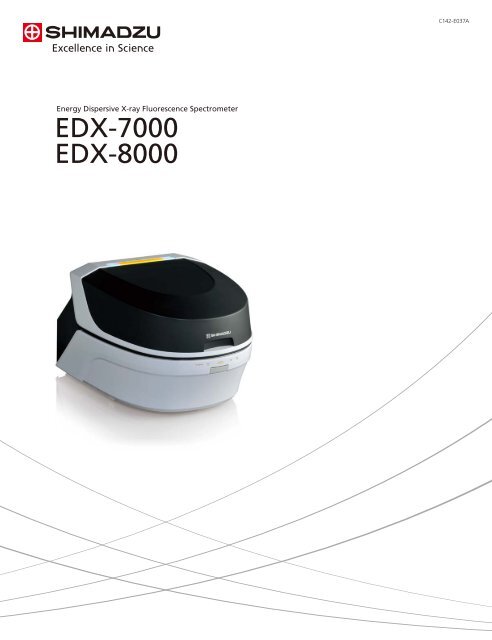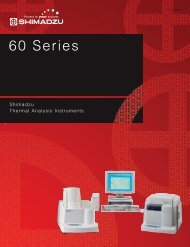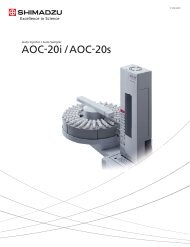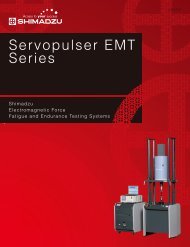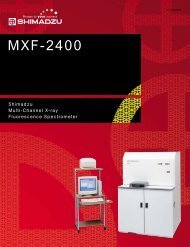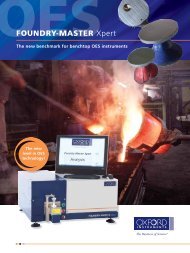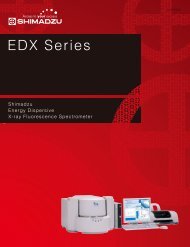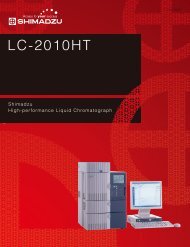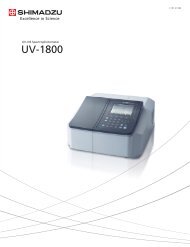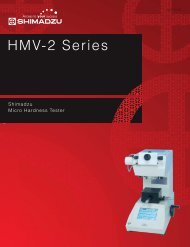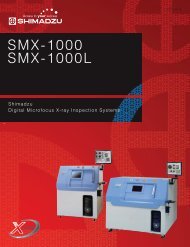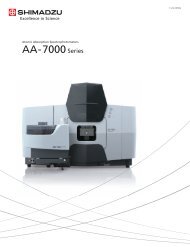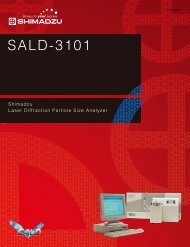EDX-7000 EDX-8000
EDX-7000 EDX-8000
EDX-7000 EDX-8000
Create successful ePaper yourself
Turn your PDF publications into a flip-book with our unique Google optimized e-Paper software.
Energy Dispersive X-ray Fluorescence Spectrometer<br />
<strong>EDX</strong>-<strong>7000</strong><br />
<strong>EDX</strong>-<strong>8000</strong><br />
C142-E037A
<strong>EDX</strong>-<strong>7000</strong>/<strong>8000</strong><br />
Energy Dispersive X-ray Fluorescence Spectrometer<br />
One <strong>EDX</strong> over all others
Principle and Features of X-ray Fluorescence Spectrometry<br />
Principle of Fluorescent X-ray Generation<br />
When a sample is irradiated with X-rays from an X-ray tube, the<br />
atoms in the sample generate unique X-rays that are emitted from<br />
the sample. Such X-rays are known as "fluorescent X-rays" and<br />
X-ray<br />
<br />
they have a unique wavelength and energy that is characteristic of<br />
each element that generates them. Consequently, qualitative<br />
analysis can be performed by investigating the wavelengths of the<br />
K<br />
X-rays. As the fluorescent X-ray intensity is a function of the<br />
concentration, quantitative analysis is also possible by measuring<br />
the amount of X-rays at the wavelength specific to each element.<br />
K shell<br />
L shell<br />
M<br />
L<br />
<br />
X-ray<br />
=0<br />
M shell<br />
L<br />
Atomic nucleus Electron Hole<br />
Electron Paths and Principle of X-ray Generation Expressed as a Bohr Model<br />
Supports Various Applications in Many Fields<br />
Electrical/electronic materials<br />
RoHS and halogen screening<br />
Thin-film analysis for semiconductors, discs, liquid crystals, and<br />
solar cells<br />
Automobiles and machinery<br />
ELV hazardous element screening<br />
Composition analysis, plating thickness measurement, and chemical<br />
conversion coating film weight measurement for machine parts<br />
Ferrous/non-ferrous metals<br />
Main component analysis and impurity analysis of raw materials,<br />
alloys, solder, and precious metals<br />
Composition analysis of slag<br />
Mining<br />
Grade analysis for mineral processing<br />
Ceramics<br />
Analysis of ceramics, cement, glass, bricks, and clay<br />
Oil and petrochemicals<br />
Analysis of sulfur in oil<br />
Analysis of additive elements and mixed elements in lubricating oil<br />
Chemicals<br />
Analysis of products and organic/inorganic raw materials<br />
Analysis of catalysts, pigments, paints, rubber, and plastics<br />
Environment<br />
Analysis of soil, effluent, combustion ash, filters, and fine<br />
particulate matter<br />
Pharmaceuticals<br />
Analysis of residual catalyst<br />
during synthesis<br />
Analysis of impurities and foreign matter in active pharmaceutical<br />
ingredients<br />
Agriculture and foods<br />
Analysis of soil, fertilizer, and plants<br />
Analysis of raw ingredients, control of added elements, and<br />
analysis of foreign matter in foods<br />
Other<br />
Composition analysis of archeological samples and precious stones,<br />
analysis of toxic heavy metals in toys and everyday goods<br />
4
<strong>EDX</strong>-<strong>7000</strong>/<strong>8000</strong> Instrument Construction<br />
Sample<br />
Collimator<br />
Primary filter<br />
Detector<br />
X-ray tube<br />
5
Unrivaled Analytical Performance<br />
The high-performance SDD detector and optimized hardware achieve a high level of sensitivity, analysis speed, and energy resolution<br />
that were previously unattainable. The <strong>EDX</strong>-<strong>8000</strong> system also permits detection from 6C.<br />
High Sensitivity− Lower Limit of Detection Improved 1.5 to 5 Times! −<br />
The high-performance SDD detector and combination of optimized optics and primary filters achieve previously unheard-of high levels of<br />
sensitivity. The sensitivity is higher than the previous Si (Li) semiconductor detector across the entire range from light to heavy elements.<br />
Lower limit of detection [ppm]<br />
<br />
<strong>EDX</strong>-<strong>7000</strong><br />
Previous model<br />
<strong>EDX</strong>-<strong>7000</strong>/<strong>8000</strong><br />
Previous model<br />
<br />
<br />
<br />
<br />
<br />
<br />
<br />
Atomic number<br />
10.0 11.0 12.0 13.0<br />
Comparison of the Lower Limit of Detection in a Light Element Matrix<br />
Profile Comparison for Lead (Pb) in Copper Alloy<br />
High Speed− Throughput Increased by up to a Factor of 10 −<br />
The high fluorescent X-ray count per unit time (high count rate) of the SDD detector permits highly precise analysis in a shorter measurement time.<br />
This feature is achieved to the maximum when analyzing samples that generate a lot of fluorescent X-rays, such as samples with a metal as the<br />
Main component element.<br />
Standard<br />
deviation<br />
Comparison Using Actual Samples<br />
<strong>EDX</strong>-<strong>7000</strong>/<strong>8000</strong><br />
Previous model<br />
Repeatability using the <strong>EDX</strong>-<strong>7000</strong>/<strong>8000</strong><br />
and the previous model were compared for<br />
lead (Pb) in lead-free solder.<br />
Sample External Appearance<br />
Measurement time<br />
Relationship Between Measurement Time and<br />
Standard Deviation (Variance in Quantitation Values)<br />
Previous model<br />
Extending the Measurement time to increase the fluorescent<br />
X-ray count can improve the precision (repeatability) of X-ray<br />
fluorescence spectrometry.<br />
The <strong>EDX</strong>-<strong>7000</strong>/<strong>8000</strong> incorporates a high-count-rate SDD<br />
detector that achieves highly precise analysis of the target in a<br />
shorter Measurement time than the previous model.<br />
<strong>EDX</strong>-<strong>7000</strong>/<strong>8000</strong><br />
Approx. 1/10 measurement time<br />
Measurement time<br />
Measurement time Required to Reach the Target Analysis Precision<br />
6
High Resolution<br />
The <strong>EDX</strong>-<strong>7000</strong>/<strong>8000</strong> instruments achieve superior energy<br />
resolution compared to previous models by incorporating a<br />
state-of-the-art SDD detector.<br />
This reduces the effects of overlapping peaks of different<br />
elements, enhancing the reliability of the analysis results.<br />
<strong>EDX</strong>-<strong>7000</strong><br />
Previous model<br />
No Liquid Nitrogen Required<br />
Comparison of Energy Resolutions (sample: PPS resin)<br />
The SDD detector is electronically cooled, eliminating the need for cooling by liquid nitrogen. This frees the user from the chore of replenishing<br />
the liquid nitrogen and contributes to lower running costs.<br />
Range of Detected Elements<br />
1<br />
2<br />
3<br />
1 18<br />
1<br />
H<br />
3<br />
Li<br />
11<br />
Na<br />
4<br />
Be<br />
12<br />
Mg<br />
<strong>EDX</strong>-<strong>7000</strong>: 11Na to 92U<br />
<strong>EDX</strong>-<strong>8000</strong>: 6C to 92U<br />
2 13 14 15 16 17<br />
Lower Detection Limits<br />
<br />
5<br />
B<br />
13<br />
Al<br />
6<br />
C<br />
14<br />
Si<br />
7<br />
N<br />
15<br />
P<br />
8<br />
O<br />
16<br />
S<br />
9<br />
F<br />
17<br />
Cl<br />
2<br />
He<br />
10<br />
Ne<br />
18<br />
Ar<br />
4<br />
19<br />
K<br />
20<br />
Ca<br />
21<br />
Sc<br />
22<br />
Ti<br />
23<br />
V<br />
24<br />
Cr<br />
25<br />
Mn<br />
26<br />
Fe<br />
27<br />
Co<br />
28<br />
Ni<br />
29<br />
Cu<br />
30<br />
Zn<br />
31<br />
Ga<br />
32<br />
Ge<br />
33<br />
As<br />
34<br />
Se<br />
35<br />
Br<br />
36<br />
Kr<br />
5<br />
37<br />
Rb<br />
38<br />
Sr<br />
39<br />
Y<br />
40<br />
Zr<br />
41<br />
Nb<br />
42<br />
Mo<br />
43<br />
Tc<br />
44<br />
Ru<br />
45<br />
Rh<br />
46<br />
Pd<br />
47<br />
Ag<br />
48<br />
Cd<br />
49<br />
In<br />
50<br />
Sn<br />
51<br />
Sb<br />
52<br />
Te<br />
53<br />
I<br />
54<br />
Xe<br />
6<br />
7<br />
55<br />
Cs<br />
87<br />
Fr<br />
56<br />
Ba<br />
88<br />
Ra<br />
57-71<br />
*<br />
89-103<br />
**<br />
72<br />
Hf<br />
104<br />
Rf<br />
73<br />
Ta<br />
105<br />
Db<br />
74<br />
W<br />
106<br />
Sg<br />
75<br />
Re<br />
107<br />
Bh<br />
76<br />
Os<br />
108<br />
Hs<br />
77<br />
Ir<br />
109<br />
Mt<br />
78<br />
Pt<br />
110<br />
Ds<br />
79<br />
Au<br />
111<br />
Rg<br />
80<br />
Hg<br />
81<br />
Tl<br />
112 113<br />
Cn<br />
UUt<br />
82<br />
Pb<br />
114<br />
Fl<br />
83<br />
Bi<br />
115<br />
UUp<br />
84<br />
Po<br />
116<br />
Lv<br />
85<br />
At<br />
117<br />
Uus<br />
86<br />
Rn<br />
118<br />
Uuo<br />
6<br />
7<br />
*<br />
**<br />
57<br />
La<br />
89<br />
Ac<br />
58<br />
Ce<br />
90<br />
Th<br />
59<br />
Pr<br />
91<br />
Pa<br />
60<br />
Nd<br />
92<br />
U<br />
61<br />
Pm<br />
93<br />
Np<br />
62<br />
Sm<br />
94<br />
Pu<br />
An optional vacuum measurement unit or helium purge unit is required to measure light elements (15P and below) with the <strong>EDX</strong>-<strong>7000</strong>.<br />
An optional vacuum measurement unit is required to measure light elements (15P and below) with the <strong>EDX</strong>-<strong>8000</strong><br />
Lower detection limit vary depending on the sample matrix or coexisting elements.<br />
63<br />
Eu<br />
95<br />
Am<br />
64<br />
Gd<br />
96<br />
Cm<br />
65<br />
Tb<br />
97<br />
Bk<br />
66<br />
Dy<br />
98<br />
Cf<br />
67<br />
Ho<br />
99<br />
Es<br />
68<br />
Er<br />
100<br />
Fm<br />
69<br />
Tm<br />
101<br />
Md<br />
70<br />
Yb<br />
102<br />
No<br />
71<br />
Lu<br />
103<br />
Lr<br />
Ultra-Light Element Analysis by <strong>EDX</strong>-<strong>8000</strong><br />
The <strong>EDX</strong>-<strong>8000</strong> features an SDD detector with a special ultra-thin-film window<br />
material that is able to detect ultra-light elements such as carbon (C), oxygen (O),<br />
and fluorine (F)<br />
LiF<br />
CF2<br />
CaF2<br />
Profile of Fluorine (F) by <strong>EDX</strong>-<strong>8000</strong><br />
<strong>EDX</strong>-<strong>7000</strong>/<strong>8000</strong><br />
Energy Dispersive X-Ray Fluorescence Spectrometer 7
Extremely Flexible<br />
Accommodates all types of samples from small to large, from powders to liquids. Options include a vacuum measurement unit and<br />
helium purge unit for highly sensitive measurement of light elements and a 12-sample turret for automated continuous measurements.<br />
Sample Observation Camera and Collimators<br />
Automatic collimator switching in four stages: 1, 3, 5, and 10 mm diameter<br />
Select the irradiation chamber from four values to suit the sample<br />
size.<br />
Select the most appropriate irradiation diameter for the sample<br />
shape: 1 mm diameter for trace foreign matter analysis or defect<br />
analysis; 3 mm or 5 mm diameter for small sample volumes.<br />
Sample observation camera included standard<br />
Use the sample observation camera to confirm the X-ray irradiation<br />
position on a specific position to measure small samples, samples<br />
comprising multiple areas, or when using a Micro X-Cell.<br />
1 mm dia. Collimator Selected<br />
5 mm dia. Collimator Selected,<br />
Using Micro X-Cell<br />
Automatic Replacement of Five Primary Filters<br />
Primary filters enhance detection sensitivity by reducing the<br />
continuous X-rays and the characteristic X-rays from the X-ray tube.<br />
They are useful for the analysis of trace elements.<br />
The <strong>EDX</strong>-<strong>7000</strong>/<strong>8000</strong> incorporates five primary filters as standard (six,<br />
including the open position), which can be automatically changed<br />
using the software.<br />
Filter<br />
#1<br />
#2<br />
#3<br />
#4<br />
#5<br />
Effective Energy keV<br />
1524<br />
25<br />
57<br />
513<br />
2124513*<br />
Target Elements (Examples)<br />
Zr, Mo, Ru, Rh, Cd<br />
Cl, Cr<br />
Cr<br />
Hg, Pb, Br<br />
Cd (Hg, Pb, Br)<br />
* This filter also cuts the background in the energy range shown in parentheses ( ).<br />
RhL line<br />
RhK line<br />
Background from<br />
continuous X-rays<br />
<br />
<br />
<br />
Sample : Cl-containing PE resin<br />
Sample : Hg/Pb-containing PE resin<br />
Effect of the Primary Filters<br />
Sample : Rh/Cd-containing aqueous solution<br />
Freely Combine Collimators and Primary Filters<br />
The collimators and primary filters are driven independently and can be combined to address specific requirements. Select the optimal<br />
combination from 24 (6 filters x 4 collimators) available options.<br />
Quantitative analysis using the FP method is possible with all combinations.<br />
8
Optional Vacuum Measurement Unit and Helium Purge Unit<br />
Sensitivity for light elements can be increased by removing atmosphere. Two options are available: a vacuum measurement unit and a helium<br />
purge unit.<br />
The helium purge unit is effective when measuring liquid samples and samples that generate a gas and cannot be measured in a vacuum.<br />
Relative intensity (%)<br />
100<br />
80<br />
60<br />
40<br />
20<br />
Cl<br />
S<br />
Ti Cr<br />
Ca<br />
K<br />
0<br />
Si<br />
5 Na 15 25 35<br />
Atomic No.<br />
Fe<br />
Zn Br Zr Cd<br />
He<br />
air<br />
Relative Sensitivity of Measurements with Helium Purging and in Air<br />
(sensitivity in vacuum = 100)<br />
45<br />
vacuum<br />
air<br />
Profile Comparison in Vacuum and Air<br />
(sample: soda-lime glass)<br />
Advanced Helium Purge Unit (Option)<br />
This proprietary system (Patent pending : PCT/JP2013/075569)<br />
efficiently purges the instrument with helium gas to achieve an<br />
approximately 40 % reduction in purge time and helium gas<br />
consumption compared to previous units.<br />
(Option for <strong>EDX</strong>-<strong>7000</strong>)<br />
He<br />
air<br />
S Ka<br />
Profile Comparison in Air and Helium After Purging<br />
(sample: sulfur in oil)<br />
12-Sample Turret (Option)<br />
The addition of the turret allows automated continuous<br />
measurements. It improves throughput, especially for measurements<br />
in a vacuum or helium atmosphere.<br />
<strong>EDX</strong>-<strong>7000</strong>/<strong>8000</strong><br />
Energy Dispersive X-Ray Fluorescence Spectrometer 9
Comprehensive Quantitation Functions<br />
Calibration Curve Method<br />
A standard sample is measured and the relationship with the fluorescent X-ray intensity<br />
plotted as a calibration curve, which is used for the quantitation of unknown samples.<br />
Although this method requires selection of a standard sample close to the unknown sample<br />
and creation of a calibration curve for each element, it achieves a high level of analysis<br />
accuracy.<br />
This method supports all types of corrections for coexistent elements,<br />
including absorption/excitation correction and correction for<br />
overlapping elements.<br />
Fundamental Parameter (FP) Method<br />
This method uses theoretical intensity calculations to determine the<br />
composition from the measured intensities. It's a powerful tool for<br />
the quantitative analysis of unknown samples in cases where<br />
preparation of a standard sample is difficult. (JP No. 03921872, DE<br />
No. 60042990. 3-08, GB No. 1054254, US No. 6314158)<br />
The instrument offers both the bulk FP method for the analysis of metals,<br />
oxides, and plastics, and the thin-film FP method that supports<br />
composition analysis and thickness measurements of plating and thin films.<br />
Automatic Balance Setting Function (Patent pending)<br />
A balance setting is required to use the FP method on principal<br />
components such as C, H, and O. The software automatically sets the<br />
balance if it determines from the profile shape that a balance setting<br />
is required.<br />
Background FP Method<br />
The background FP method adds scattered X-ray (background)<br />
calculations to the conventional FP method, which only calculates the<br />
fluorescent X-ray peak intensity (net peak intensity).<br />
(Patent pending : PCT/JP2013/78002, PCT/JP2013/78001)<br />
This method is effective at improving quantitation accuracy for small quantities<br />
of organic samples, film thickness measurements of irregular-shaped plated<br />
samples, and film thickness measurements of organic films.<br />
X-ray intensity<br />
Fluorescent X-ray<br />
intensity of quantitative<br />
element<br />
Quantitative element<br />
background<br />
Continuous X-rays<br />
Compton-scattered<br />
radiation from Rh X-ray<br />
tube target material<br />
Rayleigh-scattered<br />
radiation from Rh<br />
X-ray tube target material<br />
Matching Function<br />
Energy<br />
The matching function compares analysis data for a sample with an<br />
existing data library and displays the results in descending degree of<br />
confidence.<br />
The library contains content data and intensity data and the user can<br />
register each type. The content data values can be entered manually.<br />
Matching Results<br />
10
Functional Design<br />
Large Sample Chamber with Small Footprint<br />
Installed width is 20% smaller than the previous instrument due to its compact body size.<br />
The <strong>EDX</strong>-<strong>7000</strong>/<strong>8000</strong> can accommodate samples up to a maximum size of W300 x D275 x approx. H100 mm.<br />
<br />
<br />
275 mm<br />
300mm<br />
<br />
approx.100mm<br />
<br />
<br />
<br />
460mm<br />
High-Visibility LED Lamp<br />
When X-rays are generated, an X-ray indicator at the rear of the instrument and an X-RAYS ON lamp at the front turn on, so<br />
that the instrument status can be monitored even from a distance.<br />
<strong>EDX</strong>-<strong>7000</strong>/<strong>8000</strong><br />
Energy Dispersive X-Ray Fluorescence Spectrometer 11
PC<strong>EDX</strong> Navi Software Allows Easy Operation from the Start<br />
PC<strong>EDX</strong> Navi software is designed to simplify X-ray fluorescence spectrometry for beginners, while providing the feature set and<br />
capabilities demanded by more experienced users.<br />
The straightforward user interface offers intuitive operation and provides a convenient operating environment for beginners and<br />
experts alike.<br />
Simple Screen Layout<br />
Sample image display, analysis conditions selection, and sample name input on the same screen.<br />
Collimator Switching from the Measurement Screen<br />
Change the collimator diameter while observing the sample image.<br />
The selected diameter is indicated by a yellow circle.<br />
Automatic Storage of Sample Images<br />
The sample image is loaded automatically when the measurement starts. Sample images<br />
are saved with a link to the data file.<br />
12
Measurement Setup Screen<br />
Results Display Screen<br />
Once the measurement is complete, the<br />
element names, concentrations, 3<br />
(measurement variance) are displayed, together<br />
with the sample image, in an<br />
easy-to-understand layout.<br />
Display the result list and individual report with<br />
a single mouse click.<br />
Results List (with images)<br />
Support for Continuous Measurementss<br />
PC<strong>EDX</strong> Navi supports measurements using the<br />
optional turret.<br />
Switch between the sample image screen and<br />
sample positioning screen.<br />
Measurement Setup Screen Using the Turret (sample positioning screen)<br />
<strong>EDX</strong>-<strong>7000</strong>/<strong>8000</strong><br />
Energy Dispersive X-Ray Fluorescence Spectrometer 13
Functions to Enhance Usability<br />
Easy Instrument Startup<br />
PC<strong>EDX</strong> Navi offers instrument initialization and startup (X-ray startup)<br />
with simple mouse-click operations.<br />
After instrument startup, the stabilization function operates for 15<br />
minutes. Analysis and instrument checks are disabled during this<br />
period, ensuring that all users collect data in a stable instrument<br />
environment.<br />
Automatic X-ray Tube Aging<br />
When an X-ray tube has not been used for a long period, it requires<br />
aging before it can be used again. The software automatically<br />
performs the appropriate aging according to the period of non-use.<br />
Condition Password Protection<br />
The software offers password protection. Condition settings<br />
and changes can only be made by a person who enters the<br />
password.<br />
Incorporates General Analysis Software<br />
<strong>EDX</strong>-<strong>7000</strong>/<strong>8000</strong> incorporates PC<strong>EDX</strong> Pro software that has more<br />
flexibility functions. This software offers analysis, conditions settings,<br />
and data processing using familiar operations. It also allows loading<br />
of data profiles and quantitation values acquired with a previous<br />
Shimadzu <strong>EDX</strong> series instrument.<br />
14
Various Data Output Formats<br />
Report Creation Functions<br />
Analysis data reports can be created in HTML or Excel format. A variety of templates is available.<br />
The sample image automatically saved when measurement started is pasted in the report for confirmation of the measurement position.<br />
RoHS Screening Report in Excel Format<br />
General Analysis Report in HTML Format<br />
*Microsoft Office Excel must be purchased separately.<br />
List Creation Functions<br />
Lists of the analysis results for multiple samples can be created in Excel format. Data can be selected in the list for detailed display or editing.<br />
A variety of list generation templates is available, including a list of RoHS specific hazardous elements and user-defined lists of elements.<br />
User-Definable List of Elements<br />
*Microsoft Office Excel must be purchased separately.<br />
<strong>EDX</strong>-<strong>7000</strong>/<strong>8000</strong><br />
Energy Dispersive X-Ray Fluorescence Spectrometer 15
Comprehensive Applications<br />
Powders (Fine/Coarse Particles)−Qualification and Quantitation of Cement−<br />
The analysis of powder samples is a typical X-ray fluorescence spectrometry application. The samples can be press-formed or loose in the<br />
sample cell.<br />
The following shows an example of the analysis of a cement standard substance using Na–U qualitative/quantitative analysis, which is the<br />
standard method for powder analysis. Accurate quantitation was achieved without using standard samples. Performing measurements in a<br />
vacuum achieved sensitive measurements of light elements.<br />
Na-S<br />
K-Zn<br />
Sr<br />
Peak Profile of Cement Standard Substance<br />
Element<br />
MgO<br />
AI2O3<br />
SiO2<br />
SO3<br />
K2O<br />
CaO<br />
TiO2<br />
Mn2O3<br />
Fe2O3<br />
ZnO<br />
SrO<br />
Quantitation value<br />
1.75<br />
3.95<br />
21.86<br />
2.44<br />
0.11<br />
69.60<br />
0.079<br />
0.011<br />
0.18<br />
0.002<br />
0.023<br />
Standard value<br />
1.932<br />
3.875<br />
22.38<br />
2.086<br />
0.093<br />
67.87<br />
0.084<br />
0.0073<br />
0.152<br />
(0.001)<br />
(0.018)<br />
Sample Appearance<br />
(Press formed at 250 kN for 30 s)<br />
Comparison of Quantitative Analysis Results and Standard Values by FP Method<br />
Units: wt%<br />
Liquid, Slurry and Emulsion−Heavy Elements in Waste Oil−<br />
To measure a liquid sample, simply add it to a sample cell with film on the bottom. This method is effective for the detection and quantitation<br />
of additive components and worn metals in aqueous solutions, organic solvents, or oils.<br />
As shown below, the system achieves adequate detection of heavy elements in waste oil at ppm levels.<br />
Waste oil standard sample (50 ppm each element) Waste oil standard sample (10 ppm each element)<br />
Waste oil standard sample (30 ppm each element) Blank sample<br />
Overlaid Profiles of Heavy Elements in Waste Oil<br />
Sample Appearance<br />
(Sample cell, film, 5 mL oil)<br />
16
Foreign Matter Material Evaluation−Foreign Matter Adhering to Plastic Extruded Part−<br />
<strong>EDX</strong> permits non-destructive elemental testing, making it effective for the analysis of foreign matter adhering to or mixed in with foods, drugs,<br />
or products. Using the sample observation camera and collimators makes it easy to identify trace foreign matter.<br />
The 1 mm irradiation diameter is effective at reducing the effects of peripheral material, resulting in accurate quantitative matching. In the<br />
example, the material was identified as SUS316.<br />
Ti Ka<br />
Ti Kb<br />
Cr Ka<br />
Cr Ka Mn Kb<br />
Fe Ka<br />
Fe Kb<br />
Ni Ka<br />
Ni Kb<br />
Zn Ka<br />
Zn Kb<br />
Mo Ka<br />
Foreign matter<br />
Normal position<br />
Sample Appearance<br />
Overlaid Profiles of Foreign Matter (Red) and Normal Position (Blue)<br />
Red circle: foreign matter<br />
Blue circle: normal position<br />
Quantitative Analysis Results for Foreign<br />
Matter by FP Method<br />
The titanium (Ti) and zinc (Zn) peripheral<br />
material around the foreign matter are<br />
eliminated from the quantitation calculations.<br />
Matching Results<br />
(Matching results in internal library.<br />
Substance identified as SUS316.)<br />
Food, Biological Samples, Plants−Mineral Composition of Algae, Small Samples−<br />
<strong>EDX</strong> is used for the analysis of elements contained in foods and biological samples. It is effective for process control when adding elements to<br />
foods, evaluating the poor growth of crops, and identifying the region or origin.<br />
The new background FP function achieves similar quantitation results with low sample volumes as from adequate sample volumes. It is effective<br />
in research applications when only small samples are available and in eliminating discrepancies due to differences in sample pretreatment by<br />
operators.<br />
Adequate volume<br />
Low volume<br />
Image of Sample (Adequate Volume)<br />
Difference in Fluorescent X-Ray Intensity Due to Sample Volume<br />
Image of Sample (Low Volume)<br />
Comments<br />
With conventional FP, the changes in<br />
fluorescent X-ray intensity due to the sample<br />
quantity and shape lead to quantitation<br />
errors. Background FP eliminates these<br />
effects to achieve stable quantitation values.<br />
Quantitation value(wt%)<br />
Adequate volume<br />
Low volume_background FP<br />
Low volume_conventional FP<br />
Comparison of Quantitation Values by Background FP and Conventional FP Methods<br />
<strong>EDX</strong>-<strong>7000</strong>/<strong>8000</strong><br />
Energy Dispersive X-Ray Fluorescence Spectrometer 17
Comprehensive Applications<br />
Hazardous Elements in ProductsEight Stipulated Elements in Toys<br />
<br />
<br />
In this example with a plastic toy, comparison between measured areas indicated that the painted area contains barium (Ba), chromium (Cr),<br />
<br />
Cr Ka<br />
Pb La<br />
Br Ka<br />
Pb Lb1<br />
Sb Ka<br />
Sb Kb<br />
Ba Ka<br />
Sample Appearance<br />
Overall (Paint + plastic base material)<br />
Scraped paint<br />
Plastic base material<br />
<br />
Units: mmN.D. = not detected<br />
Element<br />
Sb<br />
As<br />
Ba<br />
Cd<br />
Cr<br />
Pb<br />
Hg<br />
Se<br />
Overall<br />
326<br />
N.D<br />
351<br />
N.D<br />
2697<br />
5010<br />
N.D<br />
12.8<br />
Scraped paint<br />
293<br />
N.D<br />
983<br />
N.D<br />
2013<br />
7918<br />
N.D<br />
19.1<br />
Polyethylene Resin Standard<br />
Samples Containing the Eight<br />
Stipulated Elements in Toys<br />
Plastic base<br />
material<br />
351<br />
N.D<br />
51<br />
N.D<br />
<br />
29<br />
77<br />
N.D<br />
N.D<br />
Plating, Thin FilmsFilm Thickness and Composition Measurements of Electroless Nickel Phosphorus Plating<br />
The film FP method permits the film thickness measurement of multilayer films, and simultaneous film thickness measurements and<br />
<br />
<br />
<br />
Cu substrate<br />
Ni, P, Pb<br />
Primary X-ray<br />
Fluorescent X-ray<br />
Schematic Representation of Sample<br />
Peak Profiles of Ni, P, and Pb<br />
Quantitative Analysis Results by Film FP Method<br />
When using the film FP method, the substrate<br />
material, film deposition sequence, and element<br />
<br />
18
Sample Preparation<br />
Solid Samples<br />
<br />
<br />
<br />
Cover the bottom of the cell<br />
<br />
<br />
Cover the measuring<br />
window with film and place<br />
<br />
Pretreatment of metal samples<br />
To enhance the quantitation precision for metal<br />
samples or to eliminate the effects of<br />
contamination or oxidation on the sample<br />
surface, machine and polish the sample surface<br />
<br />
<br />
Lathe<br />
Liquid Samples<br />
<br />
<br />
Cover the bottom of the cell<br />
<br />
If a small volume of sample results in inadequate thickness<br />
<br />
<br />
Perform measurements on<br />
sample dripped onto special<br />
<br />
Powder Samples<br />
Flat press heads<br />
Cover the bottom of the cell<br />
with film and add the sample<br />
<br />
Press form the powder with a<br />
press machine<br />
<br />
Press machine<br />
Pulverizing Samples<br />
Glass Bead Method<br />
Pulverize samples with coarse particle sizes,<br />
or samples subject to effects of<br />
non-uniformity of mineral particles on the<br />
<br />
Pulverizing<br />
container<br />
Automatic Pulverizer<br />
The glass bead method provides highly<br />
accurate analysis of oxide powders, such as<br />
<br />
such as Li2B4O<br />
<strong>EDX</strong>-<strong>7000</strong>/<strong>8000</strong><br />
Energy Dispersive X-Ray Fluorescence Spectrometer 19
PPM<br />
Screening Analysis Kits (Option)<br />
Ideal for RoHS, ELV, and Halogen Screening<br />
The optional screening analysis kits allow even beginners to start RoHS, halogen, or antimony screening analysis right from the day of purchase.<br />
Simply mount the sample, select the analysis conditions, enter the sample name, and wait for the results. The analysis results are displayed with<br />
a pass/fail evaluation after just a few minutes.<br />
Analytical results window using the RoHS, Halogen and Antimony screening kit<br />
Internal Calibration Curves and Automatic Calibration Curve Selection<br />
Internal calibration curves<br />
Internal calibration curves are provided for many materials, making it<br />
unnecessary to provide a large number of standard samples.<br />
Automatic calibration curve selection<br />
The software automatically selects the best calibration curve for the material,<br />
freeing the user from the need to select analysis conditions.<br />
As an incorrect calibration curve selection can result in large error in the<br />
quantitation results, this function contributes to improved data reliability.<br />
Shape correction<br />
The fluorescent X-ray and scattered X-ray intensities are compared for each<br />
element (BG internal standard method) to eliminate the effects of the sample<br />
shape and thickness in the quantitation values.<br />
Measured intensity ratio<br />
1.4<br />
1.2<br />
1.0<br />
0.8<br />
0.6<br />
0.4<br />
0.2<br />
0.0<br />
0.0 20.0 40.0 60.0 80.0 100.0<br />
Standard valueppm<br />
PE<br />
PVC<br />
Aluminum<br />
Steel<br />
Brass<br />
Solder<br />
20
Automatic Measurement Time Reduction<br />
This function automatically switches to the next analysis channel if a<br />
controlled substance clearly has a high or low concentration, making<br />
evaluation possible while measurement is underway. This achieves<br />
more efficient screening analysis.<br />
Concentration<br />
Above control standard<br />
Clearly above the control standard, so measurement is cut off.<br />
Gray zone. Measurement proceeds for the set time.<br />
Clearly below the control standard, so measurement is cut off.<br />
Standard value<br />
Gray zone<br />
Below control standard<br />
Screening Simple Setup Screen<br />
Threshold Values<br />
A threshold value can be set for each material and element. The screening<br />
evaluation method changes according to how the threshold values are set.<br />
Evaluation Character String<br />
Character strings can be set for display in the analysis results when the<br />
threshold value is not exceeded, in the gray zone, and when the threshold<br />
value is exceeded.<br />
Report Template<br />
Set the report style from among the templates supplied as standard.<br />
Simple Setup Screen of RoHS Screening Analysis Kit<br />
Three screening Analysis kits are available to suit different applications.<br />
RoHS Screening Analysis Kit<br />
Kit for screening cadmium, lead, mercury, chromium, and<br />
bromine. Polyethylene samples containing these five elements<br />
are supplied in the kit for instrument management.<br />
RoHS and Halogen Screening Analysis Kit<br />
In addition to cadmium, lead, mercury, chromium, and bromine,<br />
this kit also supports the screening of chlorine in plastics.<br />
Polyethylene samples containing these six elements are supplied<br />
in the kit for instrument management.<br />
RoHS, Halogen, and Antimony Screening Analysis Kit<br />
In addition to cadmium, lead, mercury, chromium, and bromine,<br />
this kit also supports the screening of chlorine and antimony in<br />
plastics. Polyethylene samples containing these seven elements<br />
are supplied in the kit for instrument management.<br />
<strong>EDX</strong>-<strong>7000</strong>/<strong>8000</strong><br />
Energy Dispersive X-Ray Fluorescence Spectrometer 21
Specifications<br />
Measurement principle<br />
X-ray fluorescence spectrometry<br />
Installation Example<br />
Measurement method<br />
Target samples<br />
Energy dispersion<br />
Solids, liquids, powders<br />
429<br />
249<br />
Units: mm<br />
Measuring range<br />
Sample size<br />
11Na to 92U (<strong>EDX</strong>-<strong>7000</strong>) 6C to 92U (<strong>EDX</strong>-<strong>8000</strong>)<br />
W 300 × D 275 × approx.H 100 mm (excluding radiuses)<br />
158<br />
Rotary pump<br />
160<br />
Switch box<br />
Maximum sample mass<br />
5kg (200g per sample when using turret, Gross mass 2.4kg)<br />
X-ray generator<br />
X-ray tube<br />
Rh target<br />
200 min.<br />
Voltage<br />
4 kV to 50 kV<br />
Current<br />
1 μA to 1000 μA<br />
Cooling method<br />
Irradiated area<br />
Air-cooled (with fan)<br />
Automatic switching in four stages: 1, 3, 5, and<br />
10 mm diameter<br />
750<br />
590<br />
Primary filters<br />
Five types (six, including the open position),<br />
automatic replacement<br />
Detector<br />
Type<br />
Silicon drift detector (SDD)<br />
Liquid nitrogen<br />
Not required (electronic cooling)<br />
Sample chamber<br />
360<br />
Measurement atmosphere<br />
Air, vacuum* 1 , helium (He)* 2<br />
Sample replacement*<br />
12-sample turret<br />
460<br />
Sample observations<br />
Semiconductor camera<br />
1200<br />
Data processor<br />
Memory<br />
HDD<br />
Optical drive<br />
OS<br />
2 GB min. (32-bit), 4 GB min. (64-bit)<br />
250 GB min.<br />
Super multi drive<br />
Windows 7 (32-bit/64-bit)* 3<br />
Vacuum measurement unit (optional) consists of a control<br />
switch box and rotary pump.<br />
Software<br />
Qualitative analysis<br />
Quantitative analysis<br />
Matching software<br />
Utilities<br />
Instrument status<br />
monitoring function<br />
Analysis results tabulation<br />
function<br />
Measurement/analysis software<br />
Calibration curve method, correction for coexistent elements,<br />
FP method, film FP method, background FP method<br />
Intensity/content<br />
Automatic calibration functions<br />
(energy calibration, FWHM calibration)<br />
Installation<br />
Temperature<br />
Relative humidity<br />
Power supply<br />
Dimensions<br />
Weight<br />
10 °C to 30 °C (temperature fluctuation rate 2 °C/hour<br />
max., temperature fluctuation range: 10 °C max.)<br />
40 % to 70 % (no condensation)<br />
100 V AC ±10 %, 15 A earthed socket<br />
W 460 × D 590 × H 360 mm<br />
Approx. 45 kg<br />
*1 Option for <strong>EDX</strong>-<strong>7000</strong>/<strong>8000</strong><br />
*2 Option for <strong>EDX</strong>-<strong>7000</strong><br />
*3 Microsoft Office is not included.<br />
This product conforms to Shimadzu's<br />
Eco-labeled designation.<br />
* Energy savings: 44.1% reduction as<br />
compared to the previous model<br />
22
Options<br />
Vacuum Measurement UnitP/N 212-25425-42<br />
Use this unit for sensitive measurements of light elements. It requires<br />
space for installation of a rotary pump and switch box at the side or<br />
rear of the desk supporting the main unit.<br />
Helium Purge UnitP/N 212-25440-41<br />
This unit is used for highly sensitive measurements of light elements<br />
in liquid samples. Does not include a helium cylinder or regulator.<br />
(Option for <strong>EDX</strong>-<strong>7000</strong>)<br />
Turret UnitP/N 212-25389-41<br />
Turret for 12 samples. It permits<br />
continuous measurements of<br />
samples up to 32 mm in diameter. It<br />
improves throughput, especially for<br />
measurements in a vacuum or<br />
helium atmosphere.<br />
Screening Analysis Kits<br />
P/N 212-25475-41<br />
RoHS/ELV Screening Analysis Kit<br />
With check samples for five elements<br />
P/N 212-25476-41<br />
RoHS and Halogen Screening Analysis Kit<br />
With check samples for six elements<br />
P/N 212-25477-41<br />
RoHS, Halogen, and Antimony Screening Analysis Kit<br />
With check samples for seven elements<br />
Mylar Film<br />
P/N 202-86501-56 (500 sheets/set)<br />
Sample-holding film (for heavy element analysis)<br />
Sample Cells<br />
3571 General Open-End X-Cell (no lid)<br />
P/N 219-85000-55 (100 cells/set)<br />
(Outer diameter: 31.6 mm, volume: 10 mL)<br />
Polyethylene sample cell for liquid and powder<br />
samples.<br />
3529 General X-Cell (with lid)<br />
P/N 219-85000-52 (100 cells/set)<br />
(Outer diameter: 32 mm, volume: 8 mL)<br />
For liquid samples. Equipped with a relief hole<br />
and liquid retainer in case of liquid expansion.<br />
3577 Micro X-Cell<br />
P/N 219-85000-54 (100 cells/set)<br />
(Outer diameter: 31.6 mm, volume: 0.5 mL)<br />
For trace samples. Recommended for use with a<br />
collimator.<br />
3561 Universal X-Cell<br />
P/N 219-85000-53 (100 cells/set)<br />
(Outer diameter: 31.6 mm, volume: 8 mL)<br />
For liquid and thin-film samples. Equipped with a<br />
relief hole and liquid retainer in case of liquid<br />
expansion. Equipped with a ring to tightly hold<br />
thin-film samples with film.<br />
* Windows is a registered trademark of Microsoft Corporation (USA) in the<br />
United States and other countries.<br />
* Additionally noted company names and product names are the trademarks or<br />
registered trademarks of the respective companies.<br />
* The notations TM and ® are not used in this document.<br />
Polypropylene Film<br />
P/N 219-82019-05 (73 mm W × 92 m roll)<br />
Sample-holding film (for light element analysis)<br />
23
<strong>EDX</strong>-<strong>7000</strong>/<strong>8000</strong><br />
Caution<br />
This unit is designated as an X-ray device.<br />
Company names, product/service names and logos used in this publication are trademarks and trade names of Shimadzu Corporation or its<br />
affiliates, whether or not they are used with trademark symbol “TM” or “®”.<br />
Third-party trademarks and trade names may be used in this publication to refer to either the entities or their products/services. Shimadzu<br />
disclaims any proprietary interest in trademarks and trade names other than its own.<br />
www.shimadzu.com/an/<br />
For Research Use Only. Not for use in diagnostic procedures.<br />
The contents of this publication are provided to you “as is” without warranty of any kind, and are subject to change without notice. Shimadzu<br />
does not assume any responsibility or liability for any damage, whether direct or indirect, relating to the use of this publication.<br />
© Shimadzu Corporation, 2013<br />
Printed in Japan 3655-10316-30AIK


